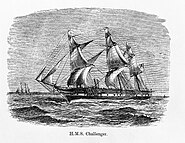| HMS Challenger (1858) | |
|---|---|
 Painting of Challenger by William Frederick Mitchell | |
| Career | |
| Name: | HMS Challenger |
| Builder: | Woolwich Dockyard |
| Launched: | 13 February 1858 |
| Decommissioned: | Chatham Dockyard, 1878 |
| Fate: | Broken for scrap, 1921 |
| General characteristics | |
| Class & type: | Pearl-class corvette |
| Displacement: | 2,137 long tons (2,171 t)[1] |
| Tons burthen: | 1465 bm[1] |
| Length: |
225 ft 3 in (68.66 m) oa 200 ft (61 m) (gundeck) |
| Beam: | 40 ft 4 in (12.29 m) |
| Draught: |
17 ft 4 in (5.28 m) (forward) 18 ft 10 in (5.74 m) (aft) |
| Depth of hold: | 23 ft 11 in (7.29 m) |
| Installed power: |
400 nominal horsepower 1,450 ihp (1,080 kW)[1] |
| Propulsion: |
|
| Sail plan: | Full-rigged ship |
| Speed: | 10.7 knots (19.8 km/h) (under steam) |
| Armament: |
|
HMS Challenger was a steam-assisted Royal Navy Pearl-class corvette launched on 13 February 1858 at the Woolwich Dockyard. She was the flagship of the Australia Station between 1866 and 1870.[2]
As part of the North America and West Indies Station she took part in 1862 in operations against Mexico, including the occupation of Vera Cruz. Assigned as the flagship of Australia Station in 1866 and in 1868 undertook a punitive operation against some Fijian natives to avenge the murder of a missionary and some of his dependents. She left the Australian Station in late 1870.[2]
She was picked to undertake the first global marine research expedition: the Challenger expedition. To enable her to probe the depths, all but two of the Challenger's guns had been removed and her spars reduced to make more space available. Laboratories, extra cabins and a special dredging platform were installed. She was loaded with specimen jars, alcohol for preservation of samples, microscopes and chemical apparatus, trawls and dredges, thermometers and water sampling bottles, sounding leads and devices to collect sediment from the sea bed and great lengths of rope with which to suspend the equipment into the ocean depths. In all she was supplied with 181 miles (291 km) of Italian hemp for sounding, trawling and dredging.
The Challenger carried a complement of 243 officers, scientists and crew when she embarked on her 68,890-nautical-mile (127,580 km) journey. She was commissioned as a Coast Guard and Royal Naval Reserve training ship at Harwich in July 1876.[2]
Despite the great success of the Challenger Expedition, the Challenger suffered an ignominious fate. She was decommissioned at the Chatham Dockyards in 1878 and remained in reserve until 1883, when she was converted into a receiving hulk in the River Medway, where she stayed until she was sold to J. B. Garnham on 6 January 1921 and broken up for her copper bottom in 1921.[2] Nothing, apart from her figurehead, now remains. This is on display in the foyer of the National Oceanography Centre, Southampton. The United States Space Shuttle Challenger was named after the ship.[3]
Image gallery[]
Citations[]
References[]
- Bastock, John (1988), Ships on the Au Station, Child & Associates Publishing Pty Ltd; Frenchs Forest, Australia. ISBN 0-86777-348-0
- Winfield, Rif; Lyon, David (2004). The Sail and Steam Navy List: All the Ships of the Royal Navy 1815–1889. London: Chatham Publishing. ISBN 978-1-86176-032-6. OCLC 52620555.
See also[]
- European and American voyages of scientific exploration
| Wikimedia Commons has media related to HMS Challenger (1858). |
The original article can be found at HMS Challenger (1858) and the edit history here.

